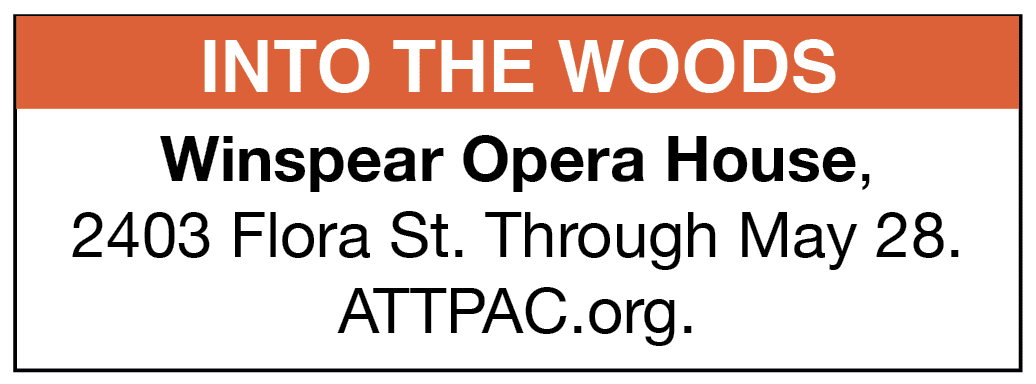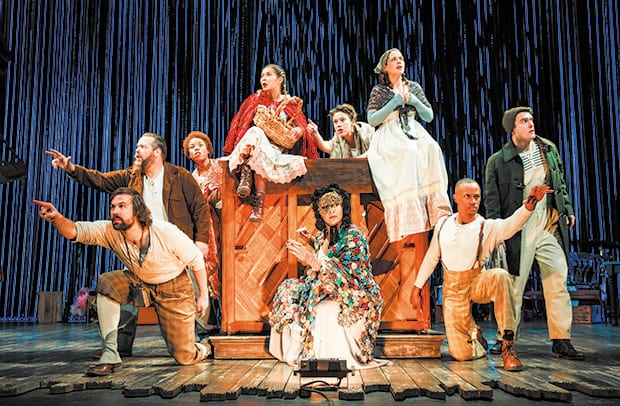
ARNOLD WAYNE JONES | Executive Editor
Here’s a sentence nobody has ever said before in reference to Into the Woods: “The cow gave the best performance.”
 As any theater fan will know, the cow — named Milky White — in the James Lapine–Stephen Sondheim fractured fairy tale musical is usually played by a plastic heifer on casters, non-Animatronic, rolled out onstage by Jack of beanstalk fame. Occasionally, a “moo” sound is added from offstage. But in the Fiasco Theater production now at the Winspear, a live human male plays the emotionally ravaged bovine, passed from owner to owner, separated and reunited from her bestie Jack, terrorized when she thinks The Baker is actually a butcher. (The same actor who plays the cow, Darick Pead, also plays Rapunzel’s Prince, one of Cinderella’s stepsisters and the occasional musical instrument.)
As any theater fan will know, the cow — named Milky White — in the James Lapine–Stephen Sondheim fractured fairy tale musical is usually played by a plastic heifer on casters, non-Animatronic, rolled out onstage by Jack of beanstalk fame. Occasionally, a “moo” sound is added from offstage. But in the Fiasco Theater production now at the Winspear, a live human male plays the emotionally ravaged bovine, passed from owner to owner, separated and reunited from her bestie Jack, terrorized when she thinks The Baker is actually a butcher. (The same actor who plays the cow, Darick Pead, also plays Rapunzel’s Prince, one of Cinderella’s stepsisters and the occasional musical instrument.)
It’s this absurdist, improv-influenced energy that sets this Into the Woods apart from most of its predecessors. Not that it needed a hook. Ask any musical-theater actor, and chances are he or she will probably name this one of their favorite Sondheim shows. It’s more or less family-friendly, despite many adult themes and double entendres. (It’s a behind-the-scenes look at the fables of Little Red Riding Hood, Rapunzel and more converging into one big universe of prince charmings and desperate maidens.) The style typically employed follows the vein of gussied-up children’s theater — the aforementioned extruded cow, two-dimensional flats as trees and buildings, colorful tights and rustic tunics that could be recycled from a bus-n-truck of Spamalot.
But here, it’s more like a group of rude mechanicals putting on a show in the proverbial barn, decorated with remnants uncovered in granny’s attic. The tree where the spirit of Cinderella’s mom lives is a dress form; flocks of birds are merely creased stationery pages; horses are of the broomstick variety; the giant’s golden harp a dime store zither. It’s not exactly that the production is minimalistic — although the dressed-down orchestrations, mostly just Evan Rees playing an upright piano while the actors play bassoons, drums and other instruments as needed. Rather, it feels as if the show is populated by found objects — sometimes, it seems, even the cast.
That’s not a criticism at all — most of them are outright terrific, insofar as they achieve co-directors Noah Broady and Ben Steinfeld’s obvious aesthetic of flamboyant overplaying. Pead and Anthony Chatmon II, who plays the other prince (as well as the Wolf and the other stepsister), seem to be engaged in a friendly battle of who can ham it up the most. Let’s call it a draw — both are so delightfully over the top, they all but charm the pants off the audience in the top balcony.
While they slapstick their landings, the women employ more emotionally resonant tricks to woo us. As The Baker’s Wife, Eleasha Gamble’s final solo isn’t just beautifully sung, it’s heart-wrenchingly acted; and Vanessa Reseland as The Witch sells two of the show’s most familiar numbers, “Witch’s Lament (Children Will Listen)” and “Last Midnight.” (Only Evan Harrington as The Baker seems disconnected from both the manic comedy of the production and its deeper meaning.)
The production enlivens the show, even for audiences who may have grown weary of it, although it clocks in at nearly three hours. That’s probably, though, because of the all the laughter and applause. Some good cow shtick can really pad a moo-sical.
This article appeared in the Dallas Voice print edition May 19, 2017.
Absurdly ever after Over-the-top and ‘Into the Woods:’ If Stomp met Sondheim

